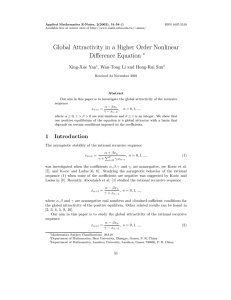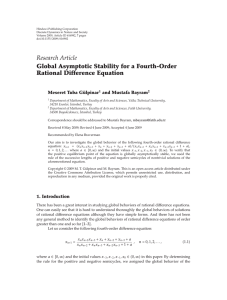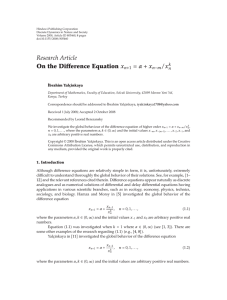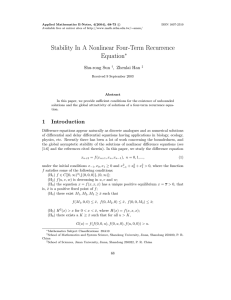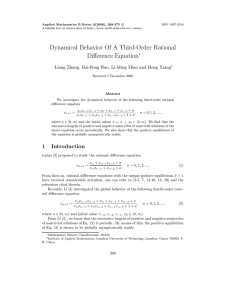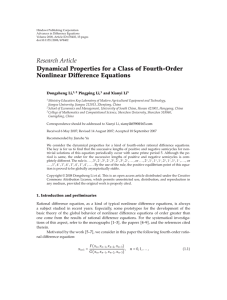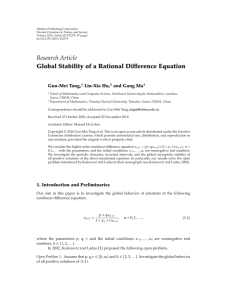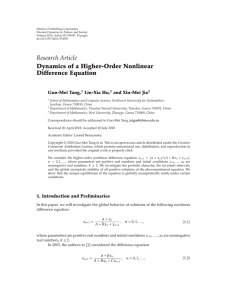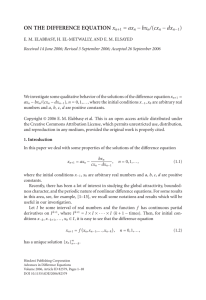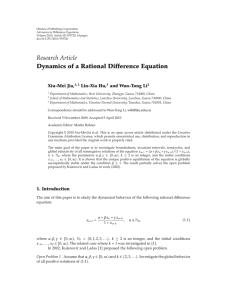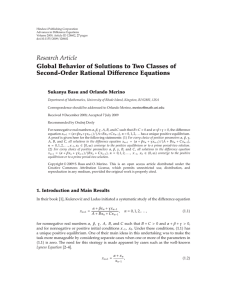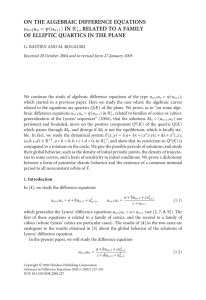Document 10677210
advertisement
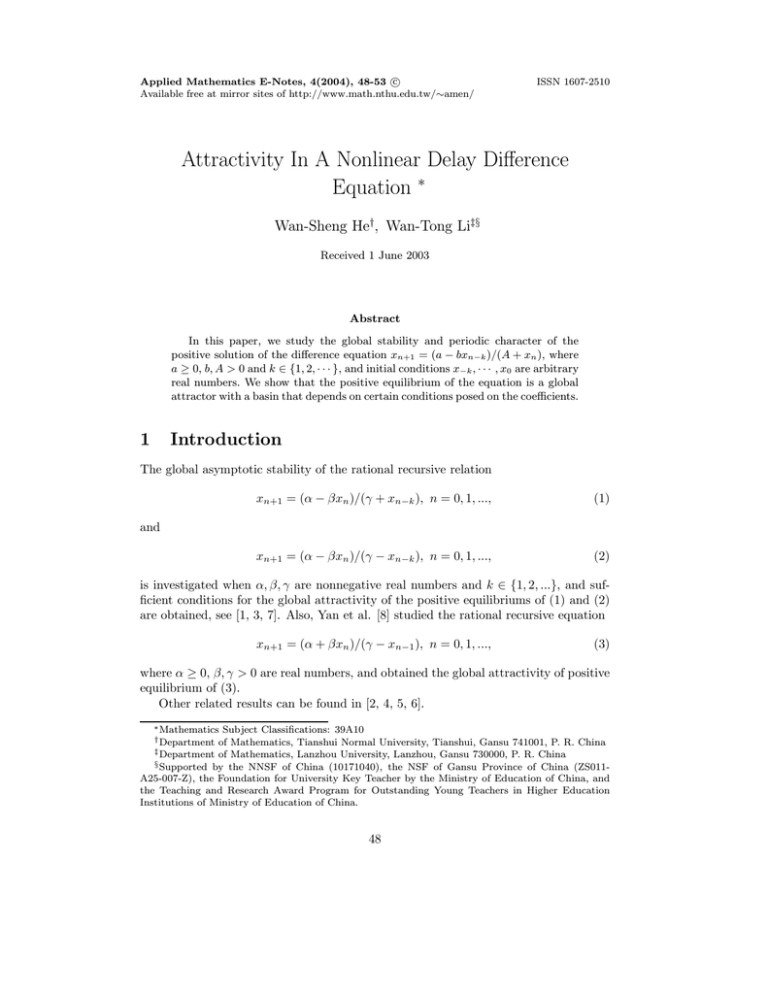
Applied Mathematics E-Notes, 4(2004), 48-53 c
Available free at mirror sites of http://www.math.nthu.edu.tw/∼amen/
ISSN 1607-2510
Attractivity In A Nonlinear Delay Difference
Equation ∗
Wan-Sheng He†, Wan-Tong Li‡§
Received 1 June 2003
Abstract
In this paper, we study the global stability and periodic character of the
positive solution of the difference equation xn+1 = (a − bxn−k )/(A + xn ), where
a ≥ 0, b, A > 0 and k ∈ {1, 2, · · · }, and initial conditions x−k , · · · , x0 are arbitrary
real numbers. We show that the positive equilibrium of the equation is a global
attractor with a basin that depends on certain conditions posed on the coefficients.
1
Introduction
The global asymptotic stability of the rational recursive relation
xn+1 = (α − βxn )/(γ + xn−k ), n = 0, 1, ...,
(1)
xn+1 = (α − βxn )/(γ − xn−k ), n = 0, 1, ...,
(2)
and
is investigated when α, β, γ are nonnegative real numbers and k ∈ {1, 2, ...}, and sufficient conditions for the global attractivity of the positive equilibriums of (1) and (2)
are obtained, see [1, 3, 7]. Also, Yan et al. [8] studied the rational recursive equation
xn+1 = (α + βxn )/(γ − xn−1 ), n = 0, 1, ...,
(3)
where α ≥ 0, β, γ > 0 are real numbers, and obtained the global attractivity of positive
equilibrium of (3).
Other related results can be found in [2, 4, 5, 6].
∗ Mathematics
Subject Classifications: 39A10
of Mathematics, Tianshui Normal University, Tianshui, Gansu 741001, P. R. China
‡ Department of Mathematics, Lanzhou University, Lanzhou, Gansu 730000, P. R. China
§ Supported by the NNSF of China (10171040), the NSF of Gansu Province of China (ZS011A25-007-Z), the Foundation for University Key Teacher by the Ministry of Education of China, and
the Teaching and Research Award Program for Outstanding Young Teachers in Higher Education
Institutions of Ministry of Education of China.
† Department
48
W. S. He and W. T. Li
49
Our aim in this paper is study the global attarctivity and periodic character of
positive solution of the rational recursive relation
xn+1 =
a − bxn−k
, n = 0, 1, ...,
A + xn
(4)
where a ≥ 0, A, b > 0 are real numbers and the initial values x−k , ..., x0 are arbitrary
real numbers. We show that the nonnegative equilibrium point of the equation is a
global attractor with a basin that depends on certain conditions of the coefficients.
We first recall some results which will be useful in the sequel.
Let I be some real interval and let F be a continuous function defined on I k+1 .
Then, for initial conditions x−k , ..., x0 ∈ I, it is easy to see that the difference equation
xn+1 = F (xn , ..., xn−k ), n = 0, 1, ...,
(5)
has a unique solution {xn }.
A point x is called an equilibrium of (5) if x = F (x, ..., x). That is, xn = x for n ≥ 0
is a solution of (5), or equivalently, is fixed point of F .
An interval J ⊂ I is called an invariant interval of (5) if
x−k , ..., x0 ∈ J ⇒ xn ∈ J, n > 0.
That is, every solution of Eq.(5) with initial conditions in J remains in J.
DEFINITION 1.1. The difference equation (5) is said to be permanent, if there
exist numbers P and Q with 0 < P ≤ Q < ∞ such that for any initial conditions
x−k , ..., x0 there exists a positive integer N which depends on the initial conditions
such that P ≤ xn ≤ Q for n ≥ N.
The linearized equation associated with (5) about the equilibrium x is
k
[
∂F
(x, ..., x)yn−i , n = 0, 1, ... .
∂u
i
i=0
yn+1 =
(6)
Its characteristic equation is
n+1
λ
k
[
∂F
=
(x, ..., x)λn−i .
∂u
i
i=0
(7)
THEOREM A [5]. Assume that F is a C 1 function and let x be an equilibrium of
(5). Then the following statements are true:
(a) If all the roots of the equation (7) lie in the open unit disk | λ |< 1, then the
equilibrium x of (5) is asymptotically stable.
(b) If at least one root of (5) has absolute value greater than one, then the equilibrium x of (5) is unstable.
THEOREM B [2, 5]. Assume that p, q ∈ R and k ∈ {1, 2, ...}. Then
|p| + |q| < 1
(8)
50
Attractivity in a Difference Equation
is a sufficient condition for asymptotic stability of the difference equation
xn+1 − pxn + qxn−k = 0, n = 0, 1, ... .
(9)
Suppose in addition that one of the following two cases holds: (a) k is odd and q < 0,
or, (b) k is even and pq < 0. Then (8) is also a necessary condition for asymptotic
stability of (9).
2
The Case a > 0
In this section, we discuss the periodic character and global attractivity of positive
solutions of (4).
Consider the difference equation (4) with
a > 0 and A, b > 0.
(10)
The unique positive equilibrium point of (4) is
s
−(A + b) + (A + b)2 + 4a
x=
.
2
The linearized equation associated with (4) about the equilibrium x is
yn+1 +
b
x
yn +
yn−k = 0, n = 0, 1, ... .
A+x
A+x
Its characteristic equation is
s
−(A + b) + (A + b)2 + 4a k
2b
k+1
s
s
λ +
= 0.
λ
+
2
A − b + (A + b) + 4a
A − b + (A + b)2 + 4a
By using Theorem B, we have the following result.
LEMMA 2.1. The following statements are true.
(i) Assume that k is even. Then the positive equilibrium x of (4) is locally asymptotically stable if and only if A > b.
(ii) Assume that k is odd. Then the positive equilibrium x of (4) is locally asymptotically stable if A > b.
In the following, we always assume that
a > 0 and A > b > 0.
(11)
Set f (u, v) = (a−bv)/(A+u), then it is easy to see that f (u, v) satisfies the following
properties.
LEMMA 2.2. Assume that (11) holds. Then the following statements are true.
a
< ab .
(i) 0 < x < A
(ii) f (x, x) is a strictly decreasing function in [0, ∞).
(iii) If (u, v) ∈ [0, ∞] × (−∞, a/b), then f (u, v) is a strictly decreasing function in
each of its arguments.
W. S. He and W. T. Li
51
THEOREM 2.1. Assume that (11) holds. Then Eq.(4) has no positive solution
with prime period two for all a ∈ [0, ∞).
PROOF. Assume for the sake of contradiction that there exist distinctive positive
real numbers φ and ψ, such that
..., φ, ψ, φ, ψ, ...
forms a period-two solution of Eq.(4). There are two cases to consider.
Case (a) k is odd.
In this case xn+1 = xn−k , φ and ψ satisfy the system
φ(A + ψ) = a − bφ and ψ(A + φ) = a − bψ.
Subtracting these equations, we get (A + b)(φ + ψ) = 0. Since φ = ψ, then we have
A + b = 0, this is a contradiction.
Case (b) k is even.
In this case xn = xn−k , φ and ψ satisfy the system
φ(A + ψ) = a − bψ and ψ(A + φ) = a − bφ.
Subtracting these equations, we obtain (A − b)(φ − ψ) = 0, so φ = ψ, which contradicts
the hypothesis φ = ψ. The proof is complete.
THEOREM 2.2. Assume that (11) holds, and let initial conditions x−k , ..., x0 ∈
[0, a/b]. Then Eq.(4) is permanent, that is, there exist constants P and Q with 0 <
P ≤ Q < ∞ such that P ≤ xn ≤ Q, for n ≥ 0.
PROOF. Set Q = f (0, 0), P = f (Q, Q). Then we have
0 < P < Q = f (0, 0) = a/A < a/b.
By part (iii) of Lemma 2.1, we have
0 = f (a/b, a/b) ≤ x1 = f (x0, x−k ) ≤ f (0, 0) = Q,
0 = f (Q, a/b) ≤ x2 = f (x1, x−k+1 ) ≤ f (0, 0) = Q,
and
0 < P = f (Q, Q) ≤ x2 = f (x1, x−k+1 ) ≤ f (0, 0) = Q.
Hence, the result follows by induction. The proof is complete.
By Theorem 2.2, we know that the interval [0, a/b] is an invariant interval of Eq.(4).
THEOREM 2.3. Assume that (11) holds. Then the positive equilibrium x of Eq.(4)
is a global attractor with the basin S = [0, a/b]k+1 .
PROOF. Let {xn } be a solution of Eq.(4) with initial condition (x−k , · · · , x0 ) ∈ S.
Then, by part (iii) of Lemma 2.1, for any u, v ∈ [0, a/b], we have
0 < f (u, v) =
a − bv
< a/b.
A+u
52
Attractivity in a Difference Equation
Hence, f ∈ C([0, a/b]2 , [0, a/b]) and is strictly decreasing in each of its arguments.
Let λ = lim inf n→∞ xn , Λ = lim supn→∞ xn , and let ε > 0 such that ε < min{a/b −
Λ, λ}. Then there exist n0 ∈ N such that λ − ε ≤ xn ≤ Λ + ε. Thus
a − b(λ − ε)
a − b(Λ + ε)
< xn+1 <
, n ≥ n0 + 1.
A + (Λ + ε)
A + (λ − ε)
Then we get the following inequality
a − b(λ − ε)
a − b(Λ + ε)
≤λ≤Λ≤
.
A + (Λ + ε)
A + (λ − ε)
This inequality yields
a − bλ
a − bΛ
≤λ≤Λ≤
,
A+Λ
A+λ
which implies that a − bΛ − Aλ ≤ λΛ ≤ a − bλ − AΛ. In view of A > b, Λ ≤ λ. Hence
λ = Λ = x, that is limn→∞ xn = x. This completes the proof.
3
The Case a = 0
In the section, we study the asymptotic stability for the difference equation
xn+1 =
−bxn−k
, n = 0, 1, ...,
A + xn
(12)
where
b, A ∈ (0, ∞), k ∈ {1, 2, ...},
(13)
and the initial condition x−k , ..., x0 are arbitrary real numbers.
By putting xn = byn , Eq.(4) yields
yn+1 =
−yn−k
, n = 0, 1, ...,
C + yn
(14)
where C = A/b > 0. Eq.(14) has two equilibria y 1 = 0 and y 2 = −(C + 1). The
linearized equations of the Eq.(14) about the equilibria y 1 and y 2 are
Zn+1 +
yi
1
Zn +
Zn−k = 0, i = 1, 2, n = 0, 1, ... .
C + yi
C + yi
For y 2 = −(C + 1), by Theorem A we can see that it is unstable. For y 1 = 0, we have
Zn+1 +
1
Zn−k = 0, n = 0, 1, ... .
C
(15)
The characteristic equation of Eq.(15) is λk+1 + 1/C = 0. Hence, by Theorem A ,
we have
W. S. He and W. T. Li
53
(i) if A > b, then y 1 is locally asymptotically stable.
(ii) if A < b, then y 1 is unstable.
(iii) if A = b, then linearized stability analysis fails.
In the sequel, we discuss the global attractivity of the zero equilibrium of Eq.(14).
So, we assume that A > b, namely, C > 1.
LEMMA 3.1. Assume that the initial conditions y−k , ..., y0 ∈ [−C + 1, C − 1]. Then
yn ∈ [−C + 1, C − 1] for n ≥ −1.
PROOF. Suppose y−k , · · · , y0 ∈ [−C + 1, C − 1]. Then we have
−C + 1 =
−y−k
C −1
C −1
−C + 1
−C + 1
≤ y1 =
≤
≤
≤
= C − 1,
C −C +1
C + y0
C + y0
C + y0
C −C +1
and
−C + 1 =
−y−k+1
C −1
C −1
−C + 1
≤
≤
≤ y2 =
= C − 1.
C −C +1
C + y1
C + y1
C −C +1
Our result now follows by induction.
By Lemma 3.1, we know that the interval [−C + 1, C − 1] is an invariant interval
of Eq.(14). Also, Lemma 3.1 implies that the following is true.
THEOREM 3.1. The equilibrium y 1 = 0 of Eq.(14) is a global attractor with a
basin S = [−C + 1, C − 1]k+1 .
References
[1] M. T. Aboutaleb, M. A. EI-Sayed and A .E. Hamzd, Stability of the recursive
sequence xn+1 = (α − βxn )/(γ + xn−1 ), J. Math. Anal. Appl., 261(2001), 126—133.
[2] R. Devault, W. Kosmala, G. Ladas and S. W. Schultz, Global behavior of yn+1 =
(p + yn−k )/(qyn + yn−k ), Nonlinear Anal. TMA, 47(2001), 4743—4751.
[3] C. H. Gibbons, M. R. S. Kulenovic and G. Ladas, On the recursive sequence xn+1 =
(α + βxn−1 )/(γ + xn ), Math. Sci. Res. Hot-Line, 4(2000), 1—11.
[4] C. H. Gibbons, M. R. S .Kulenovic, G. Ladas and H. D. Voulov, On the trichotomy
character of xn+1 = (α + βxn + γxn−1 )/(A + xn ), J. Difference Equations and
Applications, 8(1)(2002), 75-92.
[5] V. L. Kocic and G. Ladas, Global Behavior of Nonlinear Difference Equations of
Higher Order with Application, Kluwer Academic Publishers, Dordrecht, 1993.
[6] M. R. S. Kulenovic, G. Ladas, and N. R. Prokup, On the recursive sequence xn+1 =
(αxn +βxn−1 )/(1+xn ), J. Difference Equations and Applications, 5(2000), 563—576.
[7] C. H. Ou, H. S. Tang and W. Luo, Global stability for a class of difference equations,
Appl. Math. J. Chinese Univ. Ser. B., 15(2000), 33—36.
[8] X. X. Yan, W. T. Li and H. R. Sun, Global attractivity in a higher order nonlinear
difference equation, Appl. Math. E-Notes., 2(2002), 51—58.

